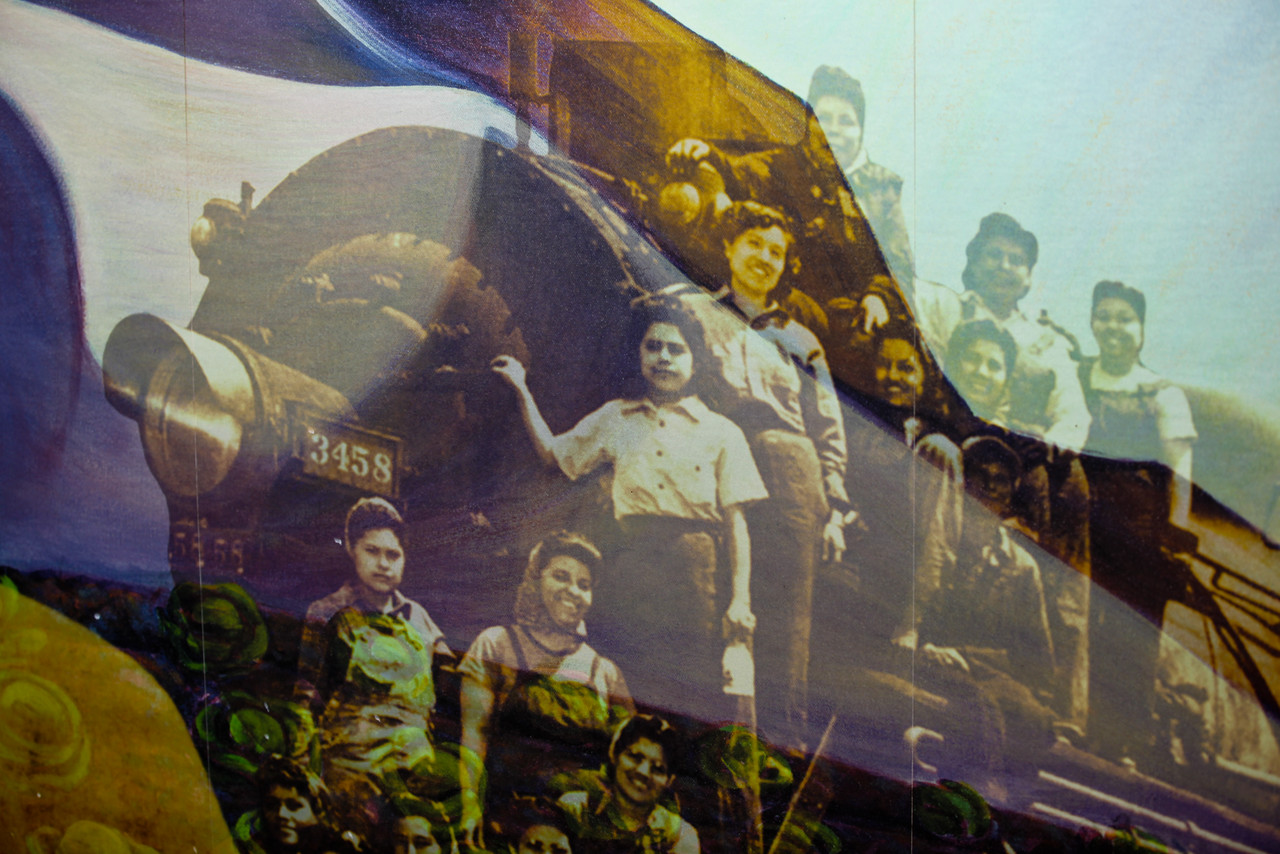
About This Tour
Denver Public Art celebrates National Hispanic Heritage Month (Sept. 15-Oct. 15) by showcasing a few of the many projects in our collection that were created by Hispanic and/or Latino/a/x artists. Latino/a/x and Hispanic culture and art is closely tied to Colorado’s history and heritage, so we would like to highlight a handful that were not only created by Hispanic and/or Latino/a/x artists, but also celebrate the culture thematically by representing people, images, stories and symbols integral to this history and heritage.
Please note that this list represents only a small number of the hundreds of pieces in our collection created by Hispanic and/or Latino/a/x artists.
 |
“César E. Chávez: Labor Leader and Civil Rights Activist” by Emanuel Martinez. This bust is located in the North Denver park named for César E. Chávez, a leader in the struggle for human and civil rights for farmworkers, and an instrumental player in establishing the United Farm Workers Union, a victory for a group of working class people who had historically been abandoned by law. |
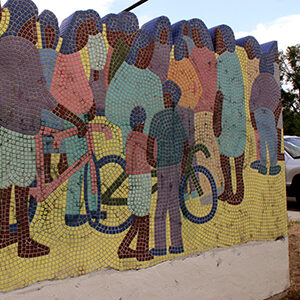 |
“Juntos / Together” by Tony Ortega. Tony Ortega visited neighborhood schools, senior centers and recreation centers, using their visitors as inspiration, and engaging the community in the creation of this piece. The handset porcelain tile mosaic mural brings a human element to the Lakewood / Dry Gulch Park, depicting groups of people interacting and enjoying the outdoors. Ortega draws from individual slices of life to create artwork centered on family and community – what he considers the two major components of the Latino. |
 |
“Crossroads / Encrucijada” by Anthony Garcia, Sr. “Crossroads / Encrucijada” marks the intersection of 6th Avenue and Federal Boulevard with four brightly colored monuments. The title of the artwork was deliberate, as was the serape theme. “This installation acts as a ‘crossroad’ or ‘gateway’ into this culturally diverse community area of Barnum, Villa Park, Valverde and Sun Valley,” explains artist Anthony Garcia, Sr. “The free-floating look of the “serape” and meaning incorporates intricate designs which represent how communities are strong and free to express emotions and ideas while still feeling protected. |
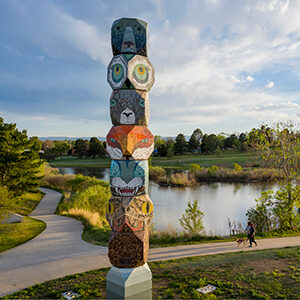 |
“La Veleta / The Weathervane” by Jaime Molina. “La Veleta” is a playful depiction of seven animal faces composed of colorful mosaic tiles stacked forty feet high, much like a totem pole. The seven animals; a bear, a lynx, a fox, a mountain lion, an owl, a ram and a snake, symbolize the diverse ecosystems found in Colorado as well as the diversity found in the surrounding neighborhoods. Jaime Molina explains: “These animals represent the diverse cultures and people of Colorado and all of the histories that come with them.” |
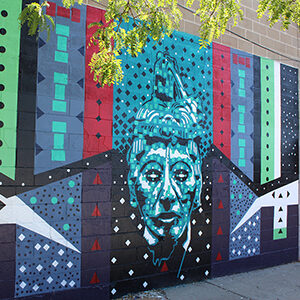 |
“Untitled (Pakal, The Mayan King)” by Josiah Lopez. The mural depicts Pakal, the Mayan King. Kʼinich Janaab Pakal was ajaw of the Maya city-state of Palenque in the Late Classic period of pre-Columbian Mesoamerican chronology. He acceded to the throne in July 615 and ruled until his death. It is said other worldly beings took his mortal body to live among the stars for eternity. Artist Josiah Lopez first learned of the legendary king in a Chicano Studies class at Metro State University and used this as inspiration for his mural. |
 |
“Infinite Energy” by Victor Contreras. “Infinite Energy” is a bronze sculpture created by Mexican artist, Victor M. Contreras in 1980 and restored in 2005. The artist has interpreted the work in two ways. In 2000 he revealed visual and narrative references, noting, “This sculpture was inspired by two white ‘mariposas’ [butterflies] in flight, which ancient Indian Mexican legends say are souls coming back to comfort their beloved.” |
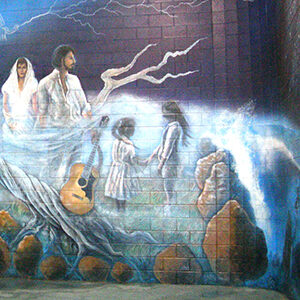 |
“La Familia Cosmica” by Jerry Jaramillo, Al Sanchez, Carlos Sandoval and Stevon Lucero. This mural was painted in 1980 at La Familia Recreation Center. The artwork explores the concept of La Raza Cósmica, the convergence of ethnic groups, by Mexican philosopher, secretary of education, and 1929 presidential candidate José Vasconcelos. Claiming that social Darwinist and racialist ideologies were only created to justify ethnic repression, Vasconelos’ theory envisioned a future amalgamation of all the races in the world with no respect to color. Along with several figures, the mural depicts the ocean stretching far into the celestial space. |
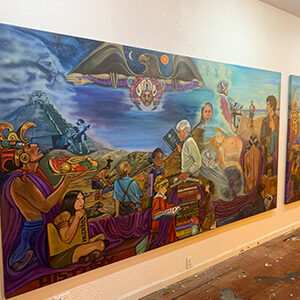 |
“Pasado, Presente, Futuro” by Carlota Espinoza. This 20-foot mural depicts people and imagery from Spanish, Mexican and Mestizo history over the past several millennia. According to the artist, “’Pasado, Presente, Futuro’ blends myth and reality, dream and truth. It is a story of a people: Chicano! It is a story of a people’s romance with history, from Aztec empires, through Spanish imperialism, from alienation to the struggle to re-win a people’s identity, pride and future. In brilliant bursts of highlight, the sweep of human experience that is uniquely Chicano unfolds in this mural.” |
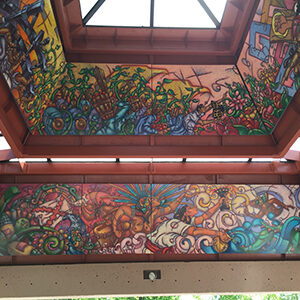 |
“El Viaje / The Journey” by David Ocelotl Garcia. This mural in La Raza Park expresses the Mexican peoples’ journey from creation to the present and into the future. To express this story, the artist used symbolic elements from history, tradition and social movements with the goal of tell a story of movement, spirituality, curiosity, character, strength, struggle, beauty, growth and positive energy. |
 |
“Que Viva Paco” by Carlos Frésquez. “Que Viva Paco” is a sculpture honoring Francisco “Paco” Sanchez, who in 1954 launched Denver’s first Spanish language radio station. The artwork consists of three stainless-steel music records, approximately five feet in diameter, painted in the colors of the United States and Mexican flags. The disks represent the Mexican and Latin music Paco would “spin” over the local airwaves. |
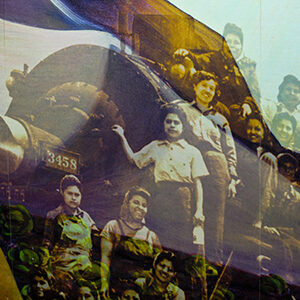 |
“La Memoria de Nuestra Tierra” by Judy Baca. The 10 foot by 50 foot mural located at Denver International Airport tells the Hispano-Mexicano history of the Southwest with specific emphasis on the Four-Corners area of the United States and Northern Mexico. The mural illustrates the migration of Mexicans through the Juarez-El Paso border region towards the north, a migration taken by Baca’s grandparents who settled in La Junta, Colorado. A landmark work in the history of Digital Murals, “La Memoria de Nuestra Tierra” combines a beautifully hand-painted landscape with historic photographs in a seamless blend imprinted upon the holographic-like surface of a metallic coated substrate. |
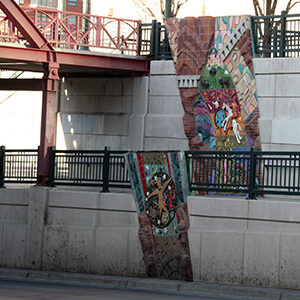 |
“A Life In Harmony With All Of Creation” by Maria Alquilar, in collaboration with Ken and Judith Williams. This handmade, hand painted brick and tile mosaic mural portrays a cross-section of Denver life and Colorado History alongside Arapaho motifs and imagery. The high relief tiles created by Maria Alquilar incorporate found objects which were uncovered during the construction of the 15th Street Underpass. Alquilar is the only woman in the U.S. General Services Administration’s catalogue of Our Hispanic Heritage. In 1990, she was awarded the General Administrations Honor Award for Bien Venida Y Vaya Con Dios, (Welcome And Go With God), a tribute to the indomitable spirit of the Mexican people. |

